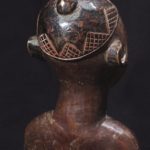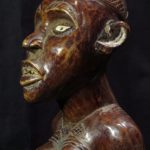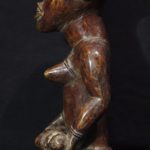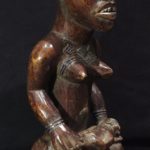Old Bakongo-Yombe Maternity Figure – PHEMBA – Republic of Congo
Mid 20th century. Wood, cm 38×14 (14.96” x 5.51” ). Grams 1.090,0 (2.40 lb)
Phemba, also known as Yombe maternity figures, refers to sculptural objects that depict the figures of a mother and child. Phemba are iconic examples of Kongo art and reflect the degree to which women are treasured in Kongo culture, not just for their fecundity, but as seers and guardians of the spirit. Kongo societies trace their descent through the female line of ancestors.
Phemba statuary falls into two groups: mothers cradling or holding their babies, and mothers nursing.
The Kikongo word phemba denotes, in anthropologist John M. Janzen’s words, ‘the one who gives children in-potentia. A phemba child is a magically conceived nkisi child, a fragile emissary of the spirit world.” The very different styles of phemba sculptures illustrate regional and even personal variations on the same theme.
In African art the concept of motherhood and maternity is a theme surfacing in just about every tribal group. Although most societies in Africa could be viewed as paternalistic or male dominated, artfully rendered maternity figures idealizing and glorifying women were commonplace. Yet, the purpose of this art was not simply to glorify women. As a genre of African art, maternity figures relate to themes of continuity, fertility, the promise of future generations, spiritual and regenerative powers, and the capacity to nurture everyone from the individual to the society at large. These themes were represented by depictions of the female form most frequently shown with a young child, but they were themes that had relevance to men and women alike.
m17
- Additional information
Additional information
| Weight | 1090 g |
|---|


















